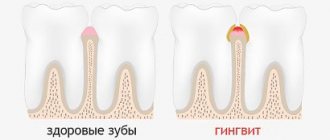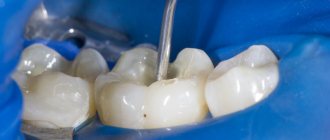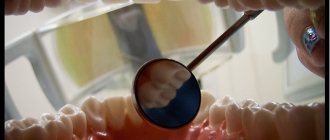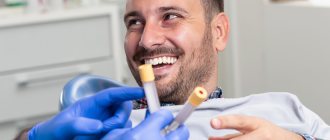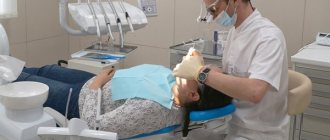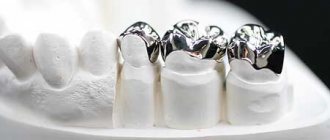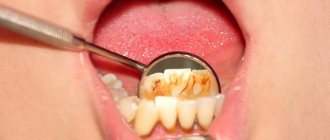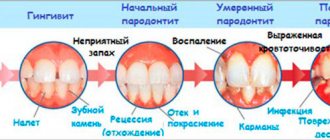HomePeriodontologyTreatment of periodontal disease with SIEMENS laser
The main reason patients visit a dental clinic is severe pain. Different diseases of the teeth and gums may have similar symptoms, and only a specialist can make an accurate diagnosis. The most common is periodontal disease. If treatment is not started in a timely manner, the development of the disease leads to inevitable tooth loss. Therefore, it is necessary to contact a dentist when the first symptoms of the disease occur.
Causes of periodontal disease development
The appearance of periodontal disease occurs for various reasons. As a result of examining more than 750 thousand patients, US scientists found that the disease primarily develops due to bacterial plaque on the teeth and a decrease in the body’s immune defense. It has been established that microorganisms that live in deposits and plaque on teeth are directly related to the development of the disease. It is the waste products of these microbes that have a negative effect on the gums and dental tissue, causing their destruction.
First, a person notices bleeding gums while brushing their teeth, which can also be accompanied by pain. Therefore, the process of oral and dental hygiene becomes more careful and of lower quality. As a result, plaque only increases, turning into tartar. At the same time, the environment for the development of microorganisms becomes especially beneficial.
During this time, inflammation and periodontal condition only worsens. Moreover, the negative process affects the activity of microvessels, which reduces nutrition, accelerating destruction. After this, the inflammatory phenomenon affects the bone tissue.
Another reason for the development of periodontal disease lies in the disruption of immune defense. The human body can be subject to disruptions due to stressful situations, trauma, and hormonal problems. As a result, immune cells perceive periodontal tissues as foreign and attack them. Such exposure causes aseptic inflammation of the gum tissue with subsequent death. Then the negative process moves to the bone tissue. The third stage of the disease is characterized by loosening and loss of teeth.
The following factors can aggravate the course of the disease: diabetes, smoking, gastrointestinal disorders, stress, hormonal imbalances, advanced caries, poor dentures and malocclusion.
Indications for laser treatment of periodontitis
Many patients with gum health problems are willing to undergo laser periodontitis treatment. Prices
acceptable for such a procedure. In addition, this method of treatment is painless and low-traumatic, and does not require long-term rehabilitation after the procedure. Let's consider for what signs a doctor may recommend laser treatment.
Indications:
- bleeding gums;
- discoloration of gum tissue;
- dental plaque, tartar;
- purulent discharge from under the gums;
- separation of soft tissues from the crown of the teeth;
- exposure of the tooth root;
- loosening of teeth;
- the appearance of putrid odor from the mouth.
The effectiveness of laser treatment is observed at almost any stage of the disease. But, there are some contraindications for which this treatment method cannot be used.
Laser treatment of periodontitis is not performed on patients:
- those suffering from severe diabetes mellitus;
- for autoimmune disorders;
- for oncological diseases;
- if there are serious diseases of the cardiovascular system;
- endocrine pathologies;
- tuberculosis;
- poor blood clotting;
- after a heart attack and surgery.
If the patient has a history of diseases included in the list of contraindications to laser treatment, the doctor will select an alternative method to combat the inflammatory process in periodontal tissues.
Periodontal disease - symptoms and signs
The first signs of the development of the disease include:
- Itching and discomfort in the gums;
- Bleeding while brushing teeth;
- Swelling and change in the shape of the gums;
- Unpleasant odor;
- Specific salty taste in the mouth.
If therapy is not started in a timely manner, purulent lesions will soon form in the gums. Pain increases, its color, shape and structure change.
In such cases, enlarged lymph nodes cannot be ruled out. And x-rays will show pathological changes in bone tissue with inflammatory foci and destruction of interdental septa.
Periodontal disease - how is it diagnosed?
Correct treatment of periodontal disease is possible only after a thorough diagnosis. However, one examination by a dentist will not be enough. You should undergo tests using modern equipment and drugs.
In the dental practice of the Bionic Dentis clinic, the German protocol is used to examine patients. This allows you to conduct a full examination and accurately make a diagnosis.
This examination includes:
- Inspection using an optical system that allows you to significantly enlarge the inspected surface and not miss even the slightest damage;
- Testing for hidden plaque on teeth. To do this, a special preparation is applied, which indicates the places where harmful microbes accumulate;
- Determination of inflammation using a marker drug that can indicate lesions;
- Bana testing, which helps identify microorganisms that cause the development of the disease. Thanks to this technique, a competent selection of antibacterial therapy occurs. Specialists from the Bionic Dentis clinic were among the first to conduct bana testing in Russia;
- An X-ray and orthopantomographic examination procedure that allows you to assess the condition of all dental tissues that are not visible during a simple examination. This helps prevent and prevent further development of inflammation.
After reviewing the results of a complete diagnosis of the patient, specialists at the Bionic Dentis clinic draw up a treatment plan. This approach allows us to completely cure 99% of patients suffering from periodontal disease who contact us.
Ultrasound method
Treatment of gums with the “Vector” device
Dental clinic “22 Century” offers its patients modern physiotherapeutic treatment of periodontitis using ultrasound.
The “Vector” ultrasound device for periodontitis helps to effectively fight bacteria and plaque, which have a detrimental effect on the tissues located around the tooth.
This treatment method has the following positive qualities :
- Ultrasound fights pathogenic microorganisms;
- Non-contact cleaning of the tooth from plaque is carried out, since the impact is through the liquid by transmitting sound waves;
- Ultrasound penetrates even the most difficult to reach places (for example, furcations, root branches), which helps to achieve the highest cleaning results ;
- Microbes from the periodontal pocket are washed out using a rinsing solution.
The disadvantage of therapeutic treatment of periodontitis using the ultrasound method is the discomfort that the patient experiences during the procedure .
Stages of a unique technique:
- 1. Begin therapy with ultrasonic cleansing of the entire tooth and its root. This removes plaque and stones. The use of ultrasound allows you to thoroughly clean even the most difficult to reach areas without pain or injury to the enamel. Specialists at the Bionic Dentis clinic perform this procedure using a special Sirosonic Sirona Siemens ultrasound device, manufactured in Germany. In this case, the level of processing is selected individually, which significantly increases work efficiency.
- 2. The second stage includes the removal of pigmented plaque and microscopic deposits located in hard-to-reach places. For this, the Air Flow technique is used. The method is implemented using a Prophyflex dental handpiece from the German company Kavo, from which mixed air and abrasive are released under high pressure. This mixture allows you to effectively eliminate the remains of infection and other contaminants. The peculiarity of the method is the use of calcium carbonate, which has a gentle effect on the gums and root system of the tooth. In combination of this drug with the Prophyflex device from Kavo, the procedure is performed with the utmost quality.
- 3. At the third stage, laser sterilization of the root pockets and gum edges is performed. Doctors at Bionic Dentis use the Sirolaser Sirona Siemens dental laser (Germany). The laser tip is inserted into the gum pockets, which leads to the complete destruction of pathogenic bacteria that cause the disease. The unique laser setting allows not to damage the gums, but to have a detrimental effect on microbes.
- 4. The fourth stage includes drug therapy using calcium copper hydroxide. The medicine is placed in the gum pockets, leaving it there for a long time. The drug relieves inflammation and sterilizes periodontal pockets in which the pathological process has begun. Our specialists use a patented original drug from the German company Humanchemie. This manufacturer is also the developer of this medicine.
- 5. At the fifth stage, the metabolism in the gingival tissues is corrected. For this purpose, the active tissue regeneration complex prf is used. The patient first donates blood from a vein, which is subjected to special treatment. This makes it possible to isolate specific prf proteins. It is these substances that can trigger tissue restoration and healing processes in the human body. Due to the fact that the proteins are obtained from the blood of a specific patient, there are no side effects or allergic manifestations. The process of obtaining active proteins for regeneration is an important and responsible procedure, which is performed under strictly sterile conditions. For this purpose, Bionic Dentis specialists use a method invented by scientists from the Munich and Charité clinics (Germany).
Purpose of the study
Development and scientific substantiation of the magnetic therapy technique at the stage of restorative treatment of patients with chronic generalized periodontitis (CGP). The results of observation of 60 patients aged 35 to 65 years with a diagnosis of moderate CGP are presented. Patients in the control group underwent pulsed carbon dioxide irrigation at an indifferent temperature for 12 minutes No. 10. Patients of the main group additionally underwent magnetic therapy No. 10 for 5 minutes on each side on the projection area of the upper and lower jaw using a labile technique. When analyzing the results of a clinical examination, the dynamics of periodontal and rheographic indices, it was established that a course of use of magnetic therapy in complex periodontal treatment makes it possible to eliminate foci of inflammation, achieve long-term stabilization of the periodontal condition, and restore the structural and functional properties of the elements of the periodontal complex.
Inflammatory periodontal diseases are a medical and social problem [1–3]. In Russia, the prevalence of these diseases in the main group of the working population (35–44 years old) is close to 100% [4]. Against the background of inflammatory periodontal diseases, microcirculation disorders occur, manifested by changes in tone, peripheral resistance, vascular elasticity, phenomena of venous stagnation, increased permeability of the vascular wall [3], and increasing depending on the clinical severity of the process and the severity of its clinical manifestations [5].
The main therapeutic measures for periodontitis should be aimed at stopping inflammation in the tissues and preventing the spread of the process [1]. Since destruction of the supporting tissues of the tooth occurs precisely during exacerbations, one of the main goals of treatment is to reduce the number and duration of periods of exacerbation and increase the duration of periods of remission [1, 6-8].
The use of magnetic therapy is recommended as the most adequate and accessible method in the complex treatment of inflammatory periodontal diseases to relieve free radical oxidation and involutive changes in connective tissue. Magnetic therapy is carried out to improve reparative processes and restore homeostasis of the periodontal complex. This method allows you to quickly relieve swelling, inflammation and pain [9, 10]. It is important to note that the use of magnetic therapy has proven itself in the complex treatment of somatically burdened patients [9].
Goal of the work
— development and scientific substantiation of magnetic therapy techniques at the stage of restorative treatment of patients with chronic generalized periodontitis (CGP).
What antibiotics are prescribed for the treatment of periodontal disease?
When contacting a specialist in a severe stage of periodontal disease, you cannot do without prescribing antibacterial therapy.
Antibiotics must be prescribed if:
- Pus was found in periodontal pockets;
- There are putrefactive-necrotic inflammations of the gingival tissue;
- The bone tissue is affected by purulent foci.
Antibacterial agents with a wide spectrum of action are used in dental practice. They show rapid activity in pathologies of any complexity, causing the death of harmful microorganisms.
The Bana test, which is used at the Bionic Dentis clinic in diagnosing periodontal disease, allows you to select effective drugs taking into account a specific clinical case.
How does vector therapy differ from other methods?
Ultrasonic treatment is widely used in dentistry. Traditional methods give good results. However, the use of Vector equipment is superior to the classical treatment approach in many cases. Important differences can be considered:
- A combined approach to canal cleaning. Ultrasound destroys deposits, and hydroxyapatite gently cleans and polishes the surface of the tooth root. This combination makes the procedure more effective and helps reduce sensitivity.
- Vertical processing. When using vector therapy, the tooth is processed parallel to its plane. On the one hand, exposure at this angle ensures high efficiency in cleaning periodontal pockets. On the other hand, it is completely safe for the tooth root, which is very important.
The process of treating periodontal disease at home includes:
- Mandatory brushing of teeth after each meal with Parodontax medicinal periodontal paste, widely used at any stage. The best tool for cleaning teeth is the Sensodyne medium toothbrush, which has medium hardness. You should also use a thin and flexible dental brush for the morning and evening procedures;
- Daily use in the evenings of an oral irrigator - a special device that cleanses the teeth and massages the gums using a stream of water and air. This improves blood flow in the vessels, has a positive effect on the condition of the periodontium, and reduces inflammation of the gingival tissue. The best irrigator is Braun Oral-B.
- Rinse your mouth thoroughly after eating using a special product;
- Lubricating the gums with Asepta gum balm, which eliminates pain and inflammation, exhibiting a disinfectant and healing effect.
- These products can be used as prescribed by a specialist, after the procedure for treating periodontal disease with ultrasound and active prf regeneration proteins has been carried out.
An integrated approach in the form of a clinical and home therapeutic course will ensure a positive result and maximum effect.
Treatment of gums with the Vector device
The main cause of gum inflammation is bacteria and plaque that accumulates in the “pockets” between the tooth and gum.
Before the advent of the Vector device, the procedure for cleaning periodontal pockets was quite complex and painful. Sometimes surgery was even required. The unique Vector device allows you to solve this problem without pain and in one visit. For this purpose, ultrasonic, mechanical and hydrodynamic effects are used simultaneously. A stream of water with small abrasive particles “washes out” bacteria and deposits, and also protects the tooth and gums from damage by mechanical elements. Therefore, the use of the Vector device is possible even with increased tooth sensitivity.
Periodontal disease treatment cost
To determine the cost of the entire course, it is important to know what mandatory procedures it includes:
- Diagnosis of gum condition, selection of medications and products for home use;
- Deep laser cleaning of gums;
- Course therapy with laser and injections of active regeneration proteins prf.
If necessary, additional measures are prescribed:
- Splinting of mobile teeth using fiberglass;
- Making a relaxation mouthguard.
As a result, the average cost of mandatory procedures that are included in the course of treatment of periodontal disease with laser and prf is 140,000 rubles.
The price of splinting teeth on one jaw using fiberglass is 35,000 rubles.
Production of a relaxation mouth guard – 20,000 rubles.
Splinting
One of the main dangers of periodontitis, as stated earlier, is the risk of tooth loss . Ignoring your condition, as well as postponing a visit to the dentist, often leads to their mobility.
If the fixation of the teeth has weakened, splinting should be performed for effective treatment, as well as to prevent loss.
The essence of the method is to connect several teeth together using a splint. As a result of such fixation, mobility is reduced , which significantly simplifies the healing process.
Splinting helps redistribute the load on the dentition when chewing food and reduces pressure on teeth affected by periodontitis.
However, it is worth considering that splinting is not possible in cases where several adjacent teeth become mobile.
Why is periodontal disease treatment expensive?
Course treatment of periodontal disease is a high-tech process, which is performed by highly qualified specialists. In their work, doctors use expensive modern equipment and original medications produced in Germany.
The Bionic Dentis dental clinic has a full arsenal of high-tech equipment: a laser, a dental orthopantomograph, a blood processing system for isolating active prf regeneration proteins, the cost of which is several million rubles.
At the Bionic Dentis clinic, patients are guaranteed the authenticity of all equipment and medications. This is confirmed by certificates of conformity and registration certificates of Roszdravnadzor.
To provide affordable treatment to a wide range of patients, the Bionic Dentis clinic offers interest-free installments for a year.
The down payment is 30% of the total cost of treatment. The remaining amount is distributed evenly over 12 months.
Russian citizens aged 18-70 years can apply for an installment plan in just 15 minutes.
Laser benefits
Due to its gentle impact, laser equipment is effective in solving almost all dental problems. It does not always replace a drill, but it successfully complements its work, since it can independently determine the affected areas, including those that are difficult to identify with the naked eye. The fact is that healthy tooth tissue does not contain moisture, and therefore boiling cannot occur in it. Many dental problems are resolved in just a few minutes and do not require a second visit to the doctor.
The beam is very thin and is able to penetrate microcavities that would otherwise require drilling with a bur. The radiation is directed to the desired location through a flexible and very thin quartz-polymer waveguide. The device itself is equipped with a compact, ergonomic head that can be easily operated by a trained physician.
Another advantage of the laser is that the surface processed by it acquires a slight roughness, which greatly improves the adhesion of the filling material. Reliable fixation reduces the likelihood of relapse to almost zero.
How to find a specialist to treat periodontal disease?
Carrying out full treatment of periodontal disease requires modern equipment and imported drugs. But the main thing is a specialist with the necessary knowledge and experience. Therefore, when choosing a periodontist, it is important that he has a certificate confirming the specialist’s qualifications. Also, the doctor must be trained in the treatment of periodontal disease using a laser and active prf regeneration proteins.
The specialists of the Bionic Dentis clinic are highly qualified and have specialized medical education. They have certificates confirming that they have completed training with German specialists.
The average experience of our periodontists is 10 years. They regularly participate in international conferences on clinical periodontology.
When choosing a periodontist, an important point is confidential communication with the patient. If a specialist explains the main features of the procedures, talks about the effects of the drugs used, possible side effects, contraindications and other aspects, then you have found your doctor!
Werner Elena Vladimirovna
Dentist periodontist
More details
Contraindications
Traditionally, there are contraindications to the use of ultrasound in the treatment of periodontal diseases such as a tendency to bleeding, acute processes in the periodontium. The use of Vector has no such restrictions. Treatment with the device cannot be carried out in the following cases:
- Installed pacemaker;
- Individual intolerance to the components of Vector Fluid Polish;
- Malignant tumors in the oral cavity;
- Acute infectious diseases.
The gentle effect of the Vector device and the possibility of using it even in an acute period give the device advantages when choosing a method of treating periodontal diseases. If treatment with the device is started in a timely manner, in many cases it is possible to avoid surgical intervention.
